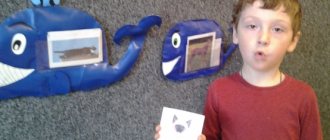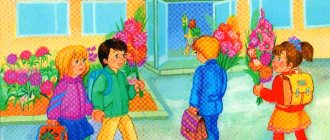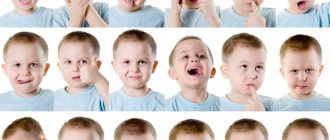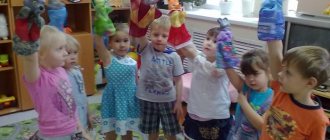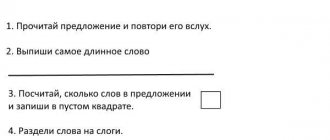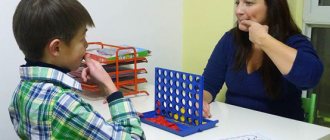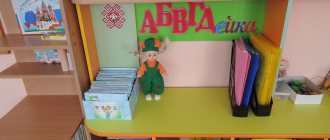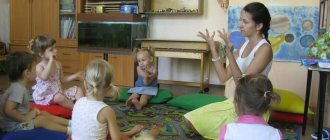The importance of logorhythmics classes in kindergarten
The main obstacle to eliminating problems in the development of speech function is that children cannot liberate themselves, and therefore, completely immerse themselves in the content of speech therapy exercises. In this case, logorhythmics (speech therapy rhythmics) comes to the aid of the teacher. This is a system of game exercises for the development and correction of speech dysfunction in children, built on the combination of verbal material, music and movements, that is, affecting the hearing, memory, speech and emotions of children. Speech therapy rhythms, classes of which begin with children of three years of age, are useful even for preschoolers who do not have speech problems. But such classes are especially relevant for children who have problems in the development of speech function, such as:
- stuttering;
- sound pronunciation disorders;
- slowing down or, conversely, speeding up the rate of speech;
- dysarthria (damage to the nervous system, characterized by limited mobility of the speech organs and causing difficulties in articulation);
- motor impairment;
- delayed speech development.
Logorhythmics combines words, movement and music
The practice of introducing logorhythmics into the educational process of preschool educational institutions shows that already after 9 months of regular classes, children, regardless of the type of speech disorders, show positive development dynamics. Along the way, kids learn to communicate with peers and adults, that is, they socialize.
This is interesting. Logorhythmics classes are conducted by a speech therapist with the participation of a music director. Individual elements of logorhythmic exercises are also introduced into the daily educational process in preschool educational institutions and are organized by the group teacher.
Goals and objectives
The development of the baby’s motor sphere in combination with music and words allows the realization of a set of educational goals:
- develops all types of motor skills (general, articulatory, fine);
- forms correct breathing, which, in turn, allows, for example, to practice the pronunciation of stops (l, l'), whistling sounds (s, s', z, z', z) and other types of sounds;
- trains the ability to navigate in space;
- helps develop precise coordinated movements associated with speech;
- promotes the development of phonemic hearing (the ability to catch and distinguish speech sounds), prosodic components (tempo and tone of speech, pauses, melody);
- develops relaxation skills;
- fosters a feeling of joy from communication in a team.
Logorhythmics classes allow you not only to correct some speech disorders, but also to solve a number of other general educational problems
Among the tasks, the solution of which contributes to the achievement of the set goals, several can be named:
- Clarification of the movements of the articulatory apparatus (position of the lips, tongue, teeth) during the pronunciation of sounds. This task is especially relevant for children of the junior and middle groups who are just beginning to master sounds (a, o, e, p, b, m - at 1–2 years old; i, s, y, x, f, v, t, d , n, k, g, x, th - at 2–3 years, s, z, c, w, g, h, sch — at 3–4 years, l, r — at 4–5 years), and very It is important that the start of this process is properly coordinated.
- Enrichment of lexical baggage. If in early preschool age this concerns the expansion of the passive vocabulary, then in the middle and older groups, when children already speak fully, this concerns to a greater extent the active vocabulary. Based on the formed verbal active and passive in older preschool age, children form a conscious speech image.
- Visual and auditory memory training. Performing exercises requires memorizing not only sounds, words, that is, information perceived by ear, but also movements seen.
- Development of motor skills. Thus, in early preschool age, training fine motor skills stimulates the work of speech centers, and children “talk” faster. In older groups, developing this type of motor skills is an important stage in preparing the hand for writing, which, in turn, is an important indicator of determining a child’s readiness for school. Physical activity, that is, performing rhythmic movements, at any age is useful for the development of general motor skills, dexterity, and flexibility.
- Formation of the ability to coordinate your movements with speech. Logorhythmic exercises require coordination of children’s actions with the instructions of an adult, and also, which is especially important in middle and older preschool age, coordination of movements and their own verbal instructions.
- Expanding the boundaries of creativity and imagination. Logorhythmic exercises can be accompanied by creative tasks. For example, performing applique from woolen threads in the second junior group during a logori lesson: after performing game actions, the kids sit at tables and glue pieces of thread onto templates with images of cats and kittens.
- Fostering camaraderie and a sense of teamwork. The participation of all children in logarithmic games is of great importance for the formation of an emotionally positive climate in the group. In middle preschool age, when children begin to play not side by side, as they did until the age of 3–4, but together, such exercises are an important stage in the transition to active ways of interacting with peers.
Forms of classes
As noted above, logorhythmics can be an integral lesson, or it can be an element of other educational courses. Thus, logorhythmic exercises are used during classes on:
- physical education;
- music;
- speech development.
Elements of speech therapy rhythms are effectively used by preschool teachers and during walks.
Most of the exercises in logorhythmics are of a playful nature.
Types of tasks in logorhythmics
Since speech therapy rhythm combines movements, words and music, these components can be represented in various combinations by a set of tasks.
Table: card index of different types of logorhythmic exercises
| Type of exercise | Features of the event | Goals | Example (age group) |
| Walking | It is an introductory task for each lesson. It becomes more difficult from time to time: marching in a circle one at a time, in pairs, threes, avoiding obstacles, towards each other, etc. |
| Walking with side steps along a rope laid out on the floor to the tune of a march, that is, a piece of music in 4/4 time. (Senior group). |
| Tasks for regulating muscle tone | It is carried out after walking. |
| To loud musical accompaniment in ¾ time, children walk with jumps in a circle; to quiet music, the step is accompanied by waving their arms up and down. (Middle group). |
| Tasks for the development of the respiratory apparatus | They stimulate not only the respiratory system, but also cardiovascular activity. |
| "Fire".
(Junior, middle, senior groups). |
| Voice development tasks | The work begins with pronouncing vowels and consonants as you exhale. | Develop strength, height and expressiveness of the voice. | Children, sitting on chairs, sing the vowels a, u, e, i, o and the syllables ma, me, mi, mo, mu, accompanied by scales in different keys. (Middle group). |
| Articulation and diction tasks | The exercises begin with imitation of the articulation of vowels without voice accompaniment. Then the voice comes in. The same work is done on consonants. |
| "Swimmers"
(Junior group). |
| Tasks for coordination of movements and speech | The rhythm of the poem should coincide with the movements of the arms and legs. The rhyme is chosen according to the plot, with the main character. |
|
(Junior and middle groups). |
| Speech attention tasks | The word is a signal to action. |
| "Beetles and Bumblebees." One team is beetles, the other is bumblebees.
(Junior group). |
| Singing | When choosing material, the age capabilities of children are taken into account (for example, in the older group, the singing range is in the range from “D” to “B” of the first octave). |
| |
| Fine motor skills training tasks (finger games) | The movements of the fingers are coordinated by the text of the rhyme. |
| "Bunnies and squirrels."
(Junior, middle groups). |
| Tasks to develop a sense of tempo | In early preschool age, tempo is mastered through simple movements (claps, waving arms); in middle and older preschool age, walking and running are added. | Practice the tempo of movements when performing exercises in a group. | "Frogs and Herons." To a slow melody, kids move in a circle on their haunches, and to a fast melody, they run and wave their arms. (Junior group). |
| Movements with objects | Movements are taught to the rhyming text at a slow pace with a gradual increase. |
| “I’m lying in the sun” (with ribbons).
(Senior, preparatory group). |
| Tasks with dance elements | The movements are selected from classical dance (postures of arms, legs) and from folk dance (rope, triple stomp, etc.). |
| "Ballet".
(Preparatory group). |
| Speech tasks | They can be accompanied by music, and then the rhythm of the line spoken must correspond to the musical rhythm. |
|
|
This is interesting. The set of logorhythmic exercises should be completed by walking at a calm pace, breathing exercises or simple general developmental exercises.
The variety of logarithmic exercises allows for a comprehensive approach to solving speech-related problems
What kids can't do without logorhythmics?
- People who stutter;
- Having problems with speech rate;
- Having problems with spatial orientation and mastering motor skills;
- Suffering from dysarthria, or diagnosed with mental retardation;
Logorhythmics tools include:
- Poetry;
- Games;
- Exercises.
Thanks to exciting lessons, children with the help of speech therapists have the opportunity to better understand the world around them. This is especially true for children 2-3 years old.
Techniques for conducting classes on logorhythmics in preschool educational institutions
As part of the educational process of a preschool educational institution, logorhythmics in the classroom is carried out using a combination of three groups of methodological techniques.
Types of verbal techniques
When working with preschoolers, listening to speech is indispensable. Especially if we are talking about speech therapy rhythm classes, where the word has a special, therapeutic role. Therefore, correction of speech functions involves the use of four types of verbal techniques.
Explanation
All tasks, including those of a gaming nature, require a detailed and detailed explanation. At the same time, it is important to remember that by imitating the teacher’s speech pattern, children gradually develop a language model for themselves. In this regard, in order to master the norms and rules of the grammatical structure, in younger groups it is recommended to formulate the explanation using the same set of speech means. Older preschoolers, on the contrary, should gain an understanding of the diversity of language capabilities, so the teacher needs to monitor the richness of his speech, saturating it with synonyms, complex syntactic constructions, and language clichés.
Even for the youngest children, it is important not only to see a sample of the exercise, but also to hear a verbal description of the order of its implementation
Puzzles
This is one of the most relevant motivational techniques in working with children. Riddles allow, on the one hand, to attract the attention of children, and on the other hand, to motivate them to do exercises and update their knowledge on the topic.
In my practice, working with children of the second junior group, before performing the “Fire” breathing apparatus development exercise, I offer students the following set of riddles with agreements:
- If something suddenly happens in the house - Smoke billows from the windows, And fire, and heat blazes - This means there... (Fire).
- The insidious fire will be defeated by the one whose name is... (Firefighter).
- A coal fell on the floor and lit the wooden floor. Don't look, don't wait, don't stand. And quickly fill it with... (Water).
This is interesting. For younger preschoolers, it is better to choose riddles with agreements. It will be easier for kids to understand what is being said, based not only on the content, but also on the rhyme.
Riddles help to attract children's attention and involve them in work
Poems
Most logorhythmic exercises are based on rhymes, so the use of poems, which are rightfully considered one of the most effective motivational techniques, should be used with caution. If the task has a rhyming basis, then you should not oversaturate the work with the same form. But the transition to exercises to regulate muscle tone, tasks with dance elements, etc. can be made poetic.
For example, when working with children in the preparatory group, before performing the “Ballet” exercise, I use the following poem:
I stand on my toes deftly and skillfully. And I soar over the stage, Like a white swan. Mischievous than the breeze, Light as a fluff, In a lush tutu, the signorina is a ballerina dancer.
After reading the poem, the children and I talk about its content. The conversation is built on the basis of questions to the text:
- What is a ballet dancer called?
- What is special about a ballerina’s movements?
- Have you been to ballet performances? What do you remember about them?
Verbal accompaniment of logorhythmic exercises usually takes the form of poetry
Short stories
This verbal technique is also a motivational one, allowing preschoolers to focus their attention on performing logorhythmic exercises.
While working with children in the preparatory group, I once encountered a problem that is usually not typical for preschoolers: my kids were embarrassed to sing, so they didn’t want to do important logorhythmic singing exercises. The story “How the Little Hare drove the Wolf away” helped to resolve the situation. “In one forest there lived a family of hares. One day, the youngest little hare went to play with his squirrel friends, and they made so much noise that they woke up the angry and hungry Gray Wolf. The Wolf got angry and ran after the kids. The little hare and the cubs hid behind the trees, but, firstly, you can’t sit like that for long - it’s scary, and mom is waiting at home, and secondly, the Wolf has a very good sense of smell, he will quickly find them. Then the Little Hare came up with the idea of singing a lullaby to the Wolf, so that the animal would want to sleep again and he would go home. The kids began to sing, the Wolf actually yawned, turned around and went to his home. And the Little Hare and his friends carefully followed him so that the Wolf could listen to the end of the song and fall asleep soundly. So they brought the beast back. He lay down, fell asleep, and the kids, feeling safe, ran home. And we also understood: you can’t make too much noise unless you’re sure that you won’t disturb anyone with loud sounds.” After listening to the fairy tale, the children and I talk about the following questions:
- Who was the Bunny's friend?
- Who did the kids wake up?
- What calmed the Wolf down?
After working with the fairy tale, the children began to view singing as a way to “lull” their fears.
This is interesting. The plots should not be too intricate, otherwise they, firstly, will no longer be short, and secondly, they will distract the kids from the task itself.
Short stories can be accompanied by finger warm-ups
Group of visual techniques
Without influencing the visual channel of perception, which is the leading channel in preschool age, it will not be possible to realize the goals and objectives of logorhythmics. Therefore, when preparing classes and exercises, it is important for the teacher to choose:
- pictures for tasks (if we are talking about tasks for the development of voice, articulation, diction, then without images illustrating game actions, it is very difficult to achieve the correct position of the speech organs in children - children must see how to position the tongue, how much to stretch the lips or open the mouth);
- demonstration material (videos, presentations that show all the stages of performing an exercise);
- toys-characters, on whose behalf the order of performing logorhythmic exercises is explained.
Practical techniques
Typically, the techniques of this group are used to summarize the results of work on logorhythmic exercises, to check the quality of children’s assimilation of the lesson material. These ways to interact with preschoolers include:
- drawings;
- applications;
- crafts;
- projects (this type of work is becoming increasingly popular in the context of maintaining connections between the kindergarten and the families of the pupils, since most of the work of this nature is carried out by the child with the help of mom or dad).
Gaming techniques
Logorhythmics exercises are mostly based on game principles. However, there are also those that do not involve game interaction. Then this type of activity can be used to motivate kids to work. For example, before performing an exercise on voice development (chanted pronunciation of syllables), I offer my pupils in the middle group the board game “Letters-Friends”, in which the children add forward (and reverse, if they have already gone through) syllables.
This is interesting. To avoid an overabundance, gaming techniques should not be combined with exercises of a gaming nature.
Board didactic games can be played to update basic knowledge or to consolidate it
How to personalize tasks
For durable and accurate memorization of material on logorhythmics, children must:
- hear;
- see;
- move.
A combination of different types of techniques helps to realize these requirements, which, in turn, allows you to individualize a specific task. For example, children who like to draw are given the task of taking a pencil “hand photo” of the group while performing an exercise-game to develop a sense of speech tempo “Frogs and Herons”. This will be a good compensation for those who do not like outdoor games.
From my work experience, I can say that the most win-win option for setting up hyperactive children who are able to change 2-3 types of activities in a matter of minutes is to delegate the motivational stage of the lesson to them. The opportunity to feel like a teacher disciplines the fidget.
This is interesting. Individualization is a priority in the selection of exercises for the correction of specific speech disorders. But since these deviations are of a medical nature, the answers to the questions of choosing an individual logorhythmic trajectory remain with the specialist (speech therapist, defectologist).
Some types of speech disorders, after diagnosis by a professional, may require individual work with a speech therapist or speech pathologist
What it is
Logorhythmics is a method of working with children in a playful way in correctional pedagogy, in which motor, verbal and musical elements are comprehensively used. It allows you to improve according to the age norm:
- Auditory and visual analyzers;
- General coordination of movements, as well as fine motor skills;
- The process of breathing and using the apparatus for articulation;
- Mental activity of children (attentiveness develops, memorization and analytical thinking improve);
- Ability to relax and control body muscles.
Preparing and conducting a lesson on logorhythmics in kindergarten
Logorhythmics classes in kindergarten, as a rule, are united by common themes, which helps preschoolers to be more organized and motivates them to complete tasks. When developing a lesson plan, the teacher evenly distributes the emotional and physical stress of his students, selects various forms of work, and takes into account the individual characteristics of the children.
Lesson time plan
The time frame for a logorhythmics lesson depends on the age of the students, for each of whom specific boundaries are established:
- in the first junior group - 15 minutes;
- in the second - 20 minutes;
- on average - 25 minutes;
- in senior and preparatory classes - 30 minutes.
The duration of logorhythmics classes depends on the age of the students
Table: step-by-step timing of the lesson
| Stage | Content | Time |
| Introductory | Warm-up march | up to 2 minutes |
| Games to develop fine motor skills | up to 5 minutes | |
| Basic | Exercises for articulation and breathing | up to 5 minutes |
| Tasks for general motor skills, games for developing tempo, melody of speech, voice, singing, tasks for practicing the tempo of speech, etc. | 5–15 minutes | |
| Final | Relaxation or general strengthening exercises | up to 3 minutes |
| Walking | 1 minute |
Drawing up notes for a lesson on logorhythmics
When creating a lesson summary for a logorhythmics lesson, the teacher selects a set of tasks that implements a current correctional or general developmental task, and also selects the necessary musical accompaniment in advance.
During the lesson, the teacher focuses on solving current educational problems
Table: example of a logori lesson summary in the younger group (fragment)
| Author | Artemenko Yu., teacher-speech therapist, teacher at MADOU “CRR kindergarten No. 40”, Perm. |
| Introductory stage | Teacher: The time has come to collect vegetables. Will we collect vegetables? (Children's answers). Speech with the “Gathering the Harvest” movement.
(A beautiful picture of vegetables appears on the screen through the projector)…> |
| Main part | <... Teacher: And now let’s become like a tomato, puff out our cheeks and, like a cucumber, thin, and hide our lips from the rain and, so as not to freeze, let’s blow on them. Articulation gymnastics. Children approach the mirror.
“Smile”, “Tube”, “Mouthpiece”. Teacher: So the tongue woke up, crawled out of the house, looked left and right, at the sky, at the puddles - and ran through them. We've got all our boots wet, let's punish the naughty tongue. Then we’ll drink tea with jam...> <... Speech with the movement “We’ll go to the garden.”
|
| The final stage | <… Musical composition “Scarecrow”. Children follow the speech therapist in a circle and sing a song. Musical composition "Goodbye, hands." Parting. Children with a speech therapist stand in a circle, hold hands and thank each other. |
| Quote from: https://www.maam.ru/detskijsad/konspekt-zanjatija-po-logoritmike-v-mladshei-grupe-ovoschi.html | |
Video: logori lesson in the second junior group
Table: example of lesson notes on logori in the senior group (fragment)
| Author | Lukmanova E., music director of MBDOU Sadovsky kindergarten, p. Sadovoye, Republic of Kalmykia. |
| Introductory stage | <… The teacher reads a poem:
Teacher: Guys, what time of year is the poem talking about? That's right, about spring. Look out the window, let's call the sun so that it can shine even brighter for us and warm us more...> <... Sun: Guys, trouble has happened! Evil Winter hid Red Spring and does not let her come to you. Find spring, save it! Teacher: Guys, I suggest you go look for Spring. Do you agree?...> |
| Main part | Teacher: Oh, look, the icicles are looking at us. You and I also know how to draw icicles, right?
Teacher: You depicted the icicles very well. But what is this I hear? Is there a strong wind blowing? (A phonogram of wind noise sounds).
You blew very well, it even became a little cold. Let's go...> |
| The final stage | <… Teacher: Well, guys, we found Spring. It's time for us to go back to kindergarten. But first, let's sit down and relax a little in the spring steppe. Close your eyes. (Music by A. Mandzhiev “Green Container”).
Teacher: So you have rested. We open our eyes. Stretch, smile. And we are already in kindergarten. Well done today: you performed all the exercises correctly, were very attentive, and found the beautiful Spring. Thank you! |
| Quote from: https://www.maam.ru/detskijsad/zanjatie-po-logoritmike-v-starshei-grupe.html | |
Video: logori lesson for older preschoolers
Drawing up a work program on logorhythmics in a preschool educational institution
For any educational course at a preschool educational institution, it is necessary to draw up a work program. And logorhythmics is no exception. However, the composition of the document remains standard:
- target section;
- content block;
- organizational components;
- bibliography;
- applications.
You can see an example of drawing up a work program on logarithmics here.
The formation of speech function is one of the determining factors in the development of a child. However, many preschool children experience some kind of speech dysfunction. At the same time, speech therapy practice shows that preschoolers performing correctly selected exercises helps correct some of these violations. An effective set of such activities is logorhythmics, which combines words, music and movement.
